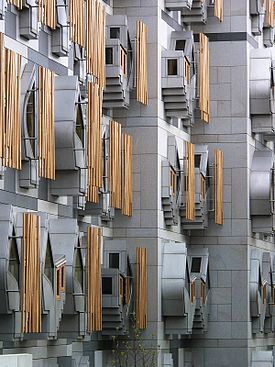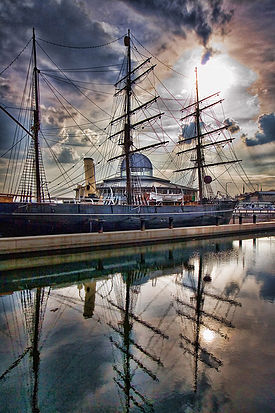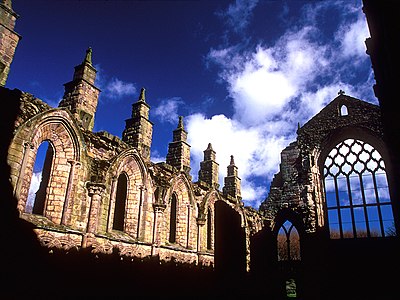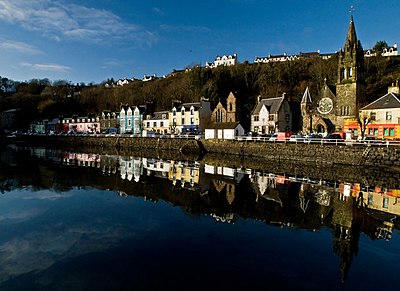Portal:Scotland/Selected picture/2013
| If you wish to suggest a possible candidate for selected article, picture or quote, see here. |
Months in 2013
[edit]- January

The Scottish Parliament Building (Scottish Gaelic: Pàrlamaid na h-Alba, Scots: Scots Pairlament Biggin) is the home of the Scottish Parliament at Holyrood, within the UNESCO World Heritage Site in central Edinburgh. Enric Miralles, the Catalan architect who designed the building, died before its completion. The building has won a number of awards, including an award at the VIII Biennial of Spanish Architecture, the RIAS Andrew Doolan Award for Architecture, and the 2005 Stirling Prize, the UK's most prestigious architecture award. The Stirling Prize judges described the building as "a statement of sparkling excellence". In October 2005 the building was identified as Scotland's 4th greatest modern building by readers of Prospect magazine.
- February

Loch Torridon (Scottish Gaelic: Loch Thoirbheartan) is a sea loch on the west coast of Scotland in the Northwest Highlands. The loch was created by glacial processes and is in total around 15 miles (25 km) long. It has two sections: Upper Loch Torridon to landward, east of Rubha na h-Airde Ghlaise, at which point it joins Loch Sheildaig; and the main western section of Loch Torridon proper. Loch a' Chracaich and Loch Beag are small inlets on the southern shores of the outer Loch, which joins the Inner Sound between the headlands of Rubha na Fearna to the south and Red Point to the north. The name Thoirbhearta has a similar root to Tarbert and indicates a place where boats were dragged overland.
- March

Edinburgh Park is a business park in South Gyle, Edinburgh, Scotland. It is west of the city, near Edinburgh Airport and the Edinburgh City Bypass, and opened in 1995. The layout of the park was masterplanned by American architect Richard Meier. Edinburgh Park railway station, which is on the Glasgow to Edinburgh via Falkirk Line, opened in December 2003, and it is planned that the Edinburgh Tram Network will pass through the park.
It is not to be confused with Gyle Park nearby, site of the former Gogarloch. The park has a bar/grill, nursery, and several sculptures, including busts of famous Scottish poets, many of them socialists.
- April

The Cuillin (Scottish Gaelic: An Cuilthionn or An Cuiltheann) are properly and locally known as The Cuillins in the plural, and are a range of rocky mountains located on the Isle of Skye in Scotland. The true Cuillin is also known as the Black Cuillin to distinguish it from the Red Hills (na Beanntan Dearga) across Glen Sligachan. The Red Hills are lower and, being less rocky, have fewer scrambles or climbs. The highest point of the Cuillins, and of the Isle of Skye, is Sgùrr Alasdair in the Black Cuillins at 992 m (3,255 ft). The Cuillins are one of 40 National Scenic Areas in Scotland.
- May

The Quiraing is a landslip on the eastern face of Meall na Suiramach, the northernmost summit of the Trotternish Ridge on the Isle of Skye. The whole of the Trotternish Ridge escarpment was formed by a great series of landslips; the Quiraing is the only part of the slip still moving, the road at its base near Flodigarry requires repairs each year.
- June

RRS Discovery was the last traditional wooden three-masted ship to be built in Britain. Designed for Antarctic research, she was launched as a Royal Research Ship (RRS) in 1901. Her first mission was the British National Antarctic Expedition, carrying Robert Falcon Scott and Ernest Shackleton on their first, successful journey to the Antarctic, known as the Discovery Expedition. She is now the centrepiece of visitor attraction in her home, Dundee. On 16 March 1900, in the context of significant donations to the approaching expedition by patrons Llewellyn W. Longstaff and the British Government, construction on the Discovery began in Dundee, Scotland, by the Dundee Shipbuilders Company. She was launched into the Firth of Tay on 21 March 1901 by Lady Markham, the wife of Sir Clements Markham, President of the Royal Geographical Society.
- July

Skara Brae (/ˈskærə ˈbreɪ/) is a stone-built Neolithic settlement, located on the Bay of Skaill on the west coast of Mainland, the largest island in the Orkney archipelago of Scotland. It consists of eight clustered houses, and was occupied from roughly 3180 BCE–2500 BCE. Europe's most complete Neolithic village, Skara Brae gained UNESCO World Heritage Site status as one of four sites making up "The Heart of Neolithic Orkney."a Older than Stonehenge and the Great Pyramids, it has been called the "Scottish Pompeii" because of its excellent preservation.
- August

Holyrood Abbey is a ruined abbey of the Canons Regular in Edinburgh, Scotland. The abbey was founded in 1128 by King David I. During the 15th century, the abbey guesthouse was developed into a royal residence, and after the Scottish Reformation the Palace of Holyroodhouse was expanded further. The abbey church was used as a parish church until the 17th century, and has been ruined since the 18th century. The remaining walls of the abbey lie adjacent to the palace, at the eastern end of Edinburgh's Royal Mile. The site of the abbey is protected as a scheduled monument
- September

Hopetoun House is the traditional residence of the Earl of Hopetoun (later the Marquess of Linlithgow). Located near South Queensferry to the west of Edinburgh, Scotland, it was built 1699-1701 and designed by William Bruce. The House was then hugely extended from 1721 by William Adam until his death in 1748 being one of his most notable projects. The interior was completed by his sons John Adam and Robert Adam. The magnificent entrance hall dates from 1752
- October

Tobermory, Mull (/ˌtoʊbərˈmɔːri/; Scottish Gaelic: Tobar Mhoire) is the capital of, and the only burgh on, the Isle of Mull in the Scottish Inner Hebrides. It is located in the northeastern part of the island, near the northern entrance of the Sound of Mull. With a current population of approximately 700, the town was founded as a fishing port in 1788, its layout based on the designs of Dumfriesshire engineer Thomas Telford.
- November

Standing Stones of Stenness is a Neolithic monument on the mainland of Orkney, Scotland. Various traditions associated with the stones survived into the modern era and they form part of the Heart of Neolithic Orkney World Heritage Site. They are looked after by Historic Scotland. The surviving stones are sited on a promontory at the south bank of the stream that joins the southern ends of the sea loch Loch of Stenness and the freshwater Loch of Harray. The name, which is pronounced stane-is in Orcadian dialect, comes from Old Norse meaning stone headland.
- December

Braemar /breɪˈmɑːr/ ⓘ is a village in Aberdeenshire, Scotland, around 58 miles (93 km) west of Aberdeen in the Highlands. It is the closest significantly-sized settlement to the upper course of the River Dee sitting at an altitude of 339 metres (1,112 ft). Braemar is the third coldest low lying place in the UK, after the villages of Dalwhinnie and Leadhills, with an annual average temperature of 6.8 °C. It has twice entered the UK Weather Records with the lowest ever UK temperature of -27.2oC, on 11 February 1895, and 10 January 1982.

